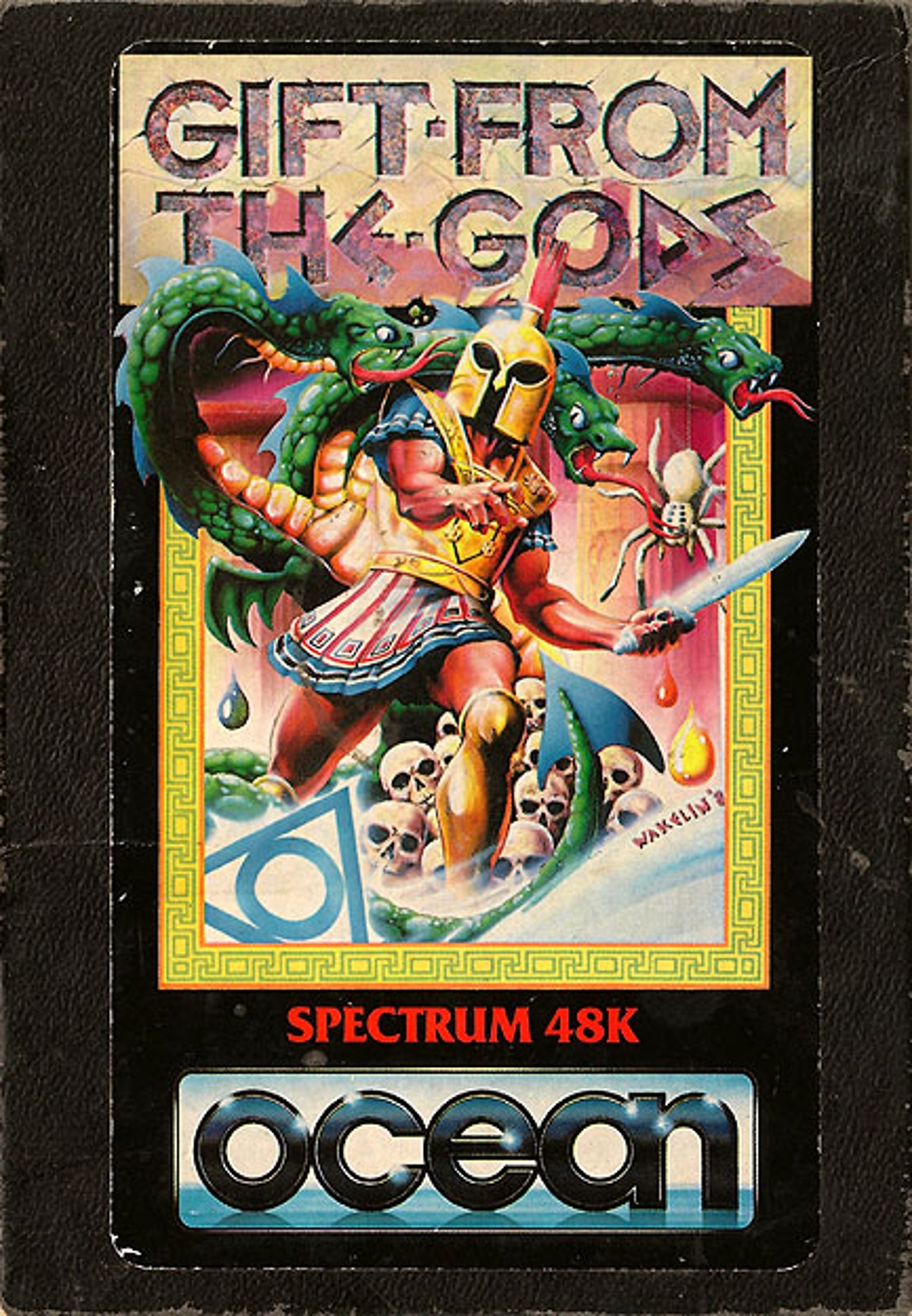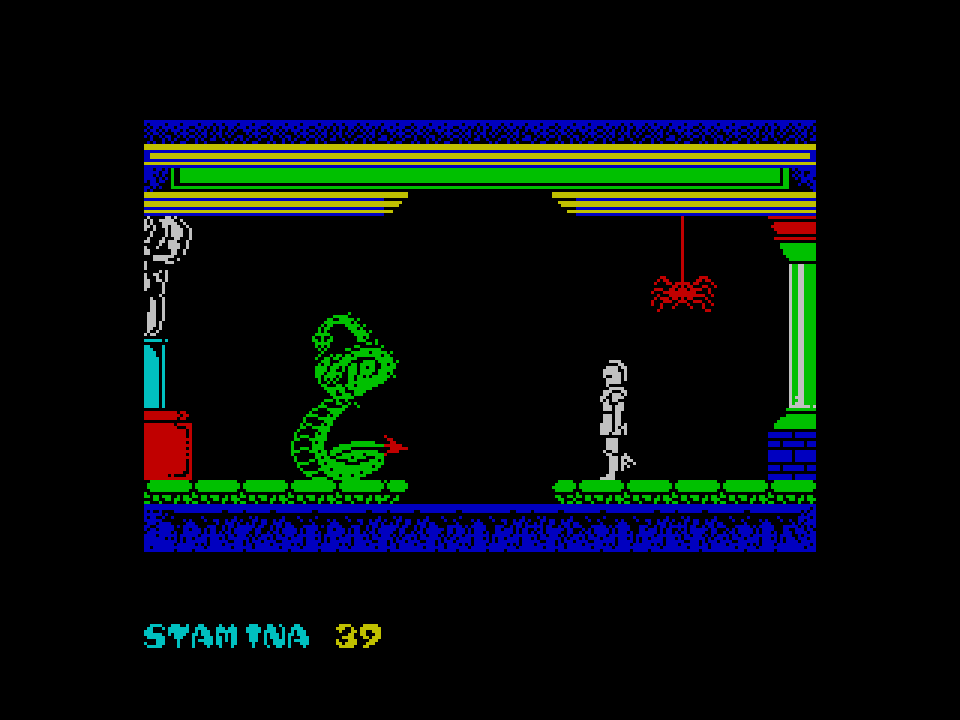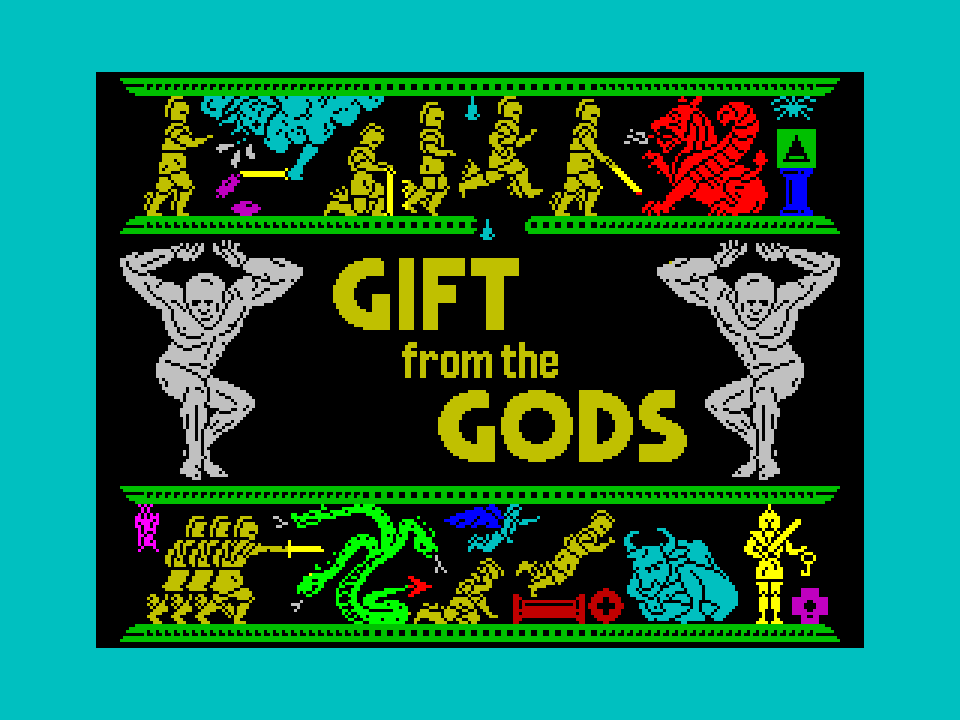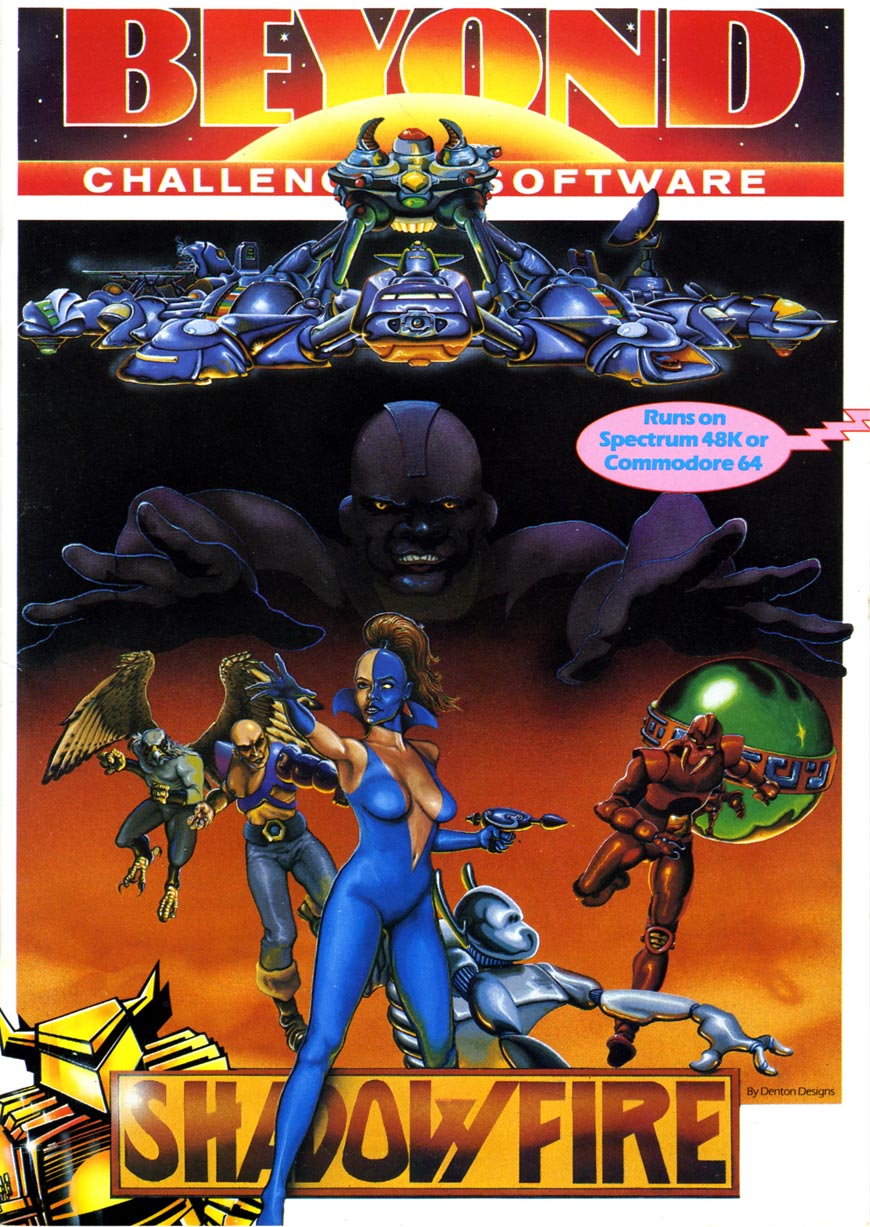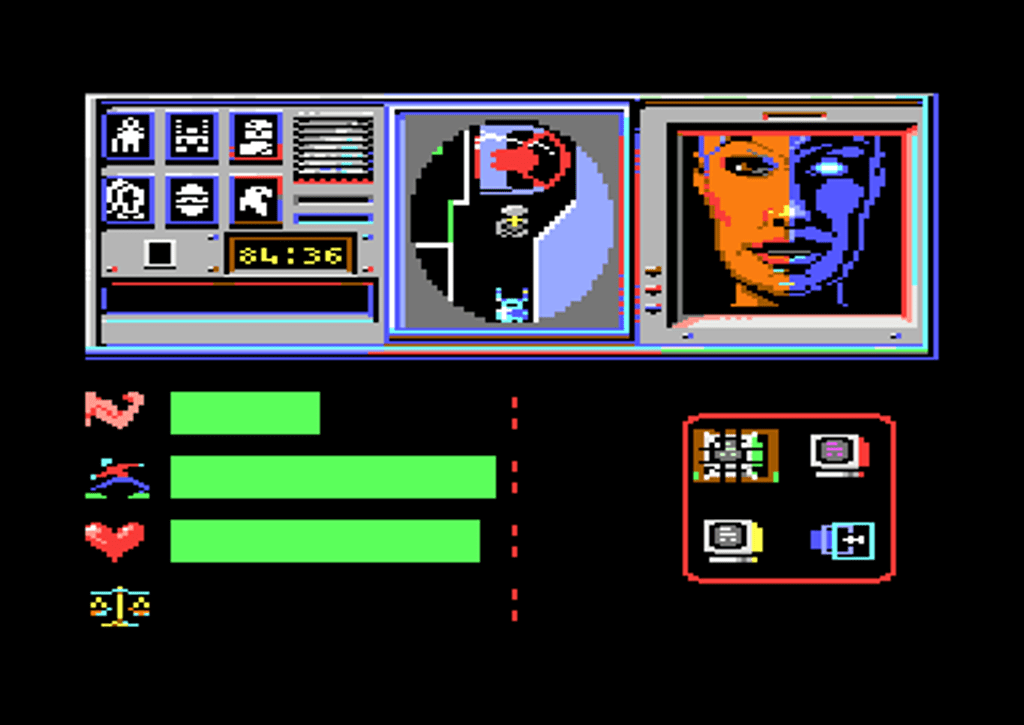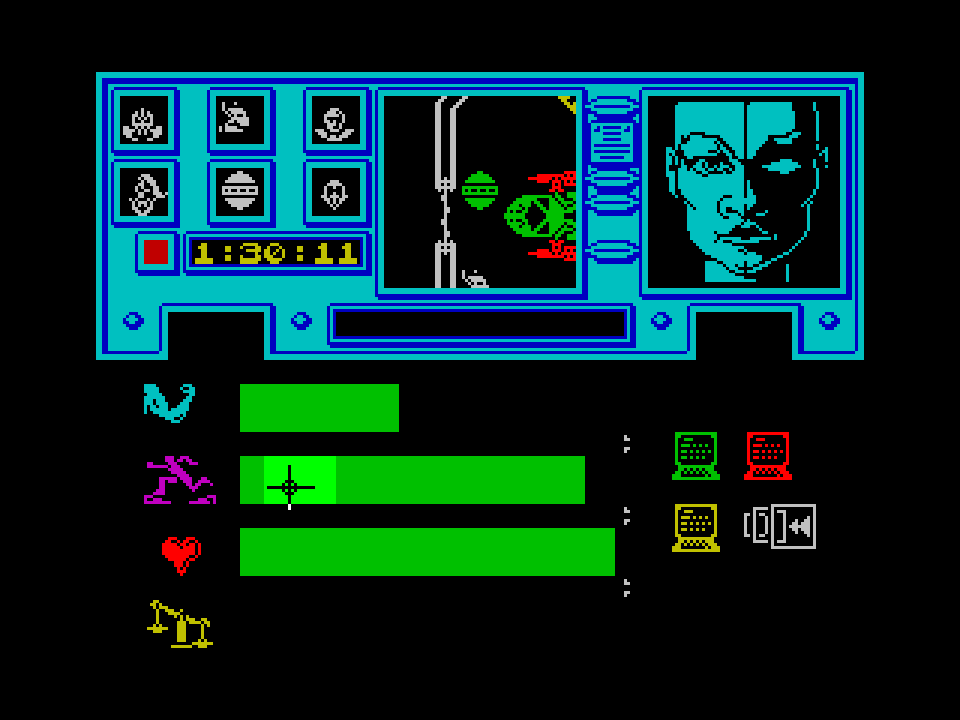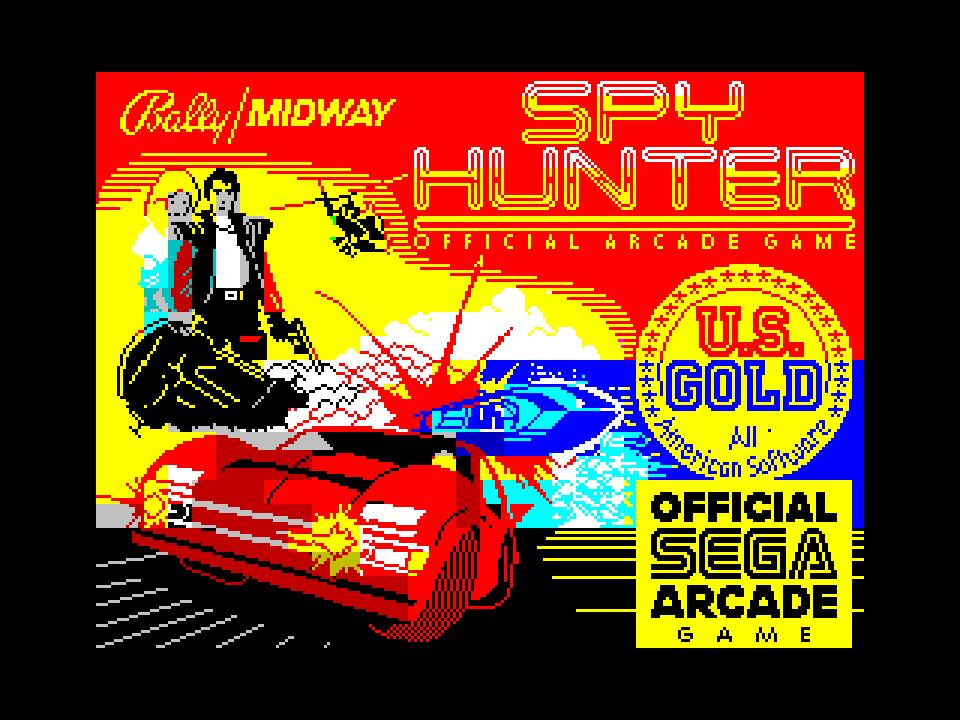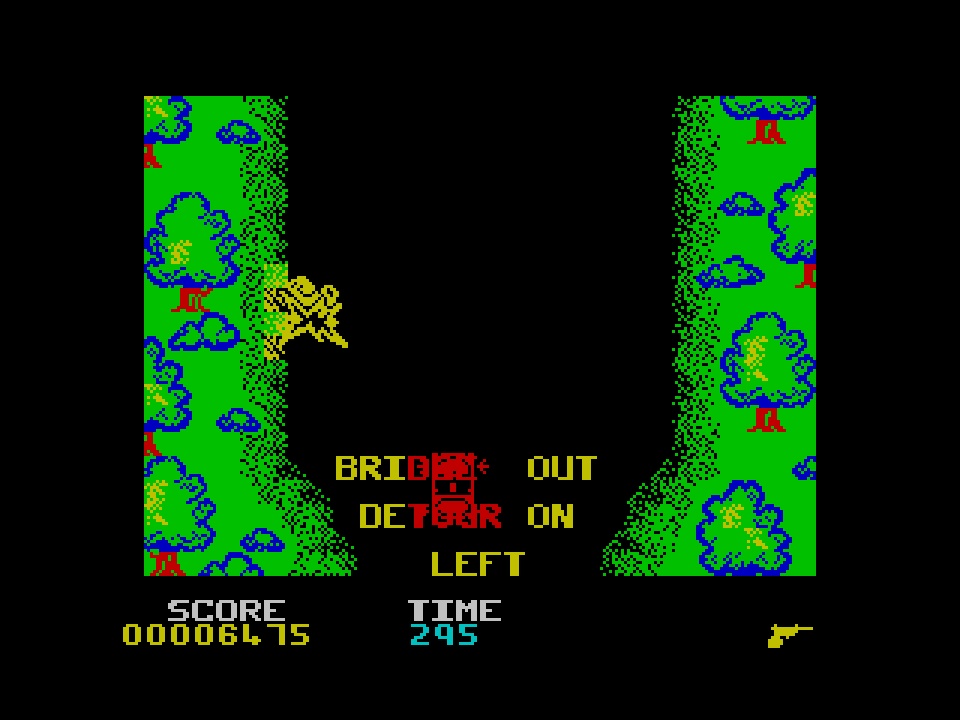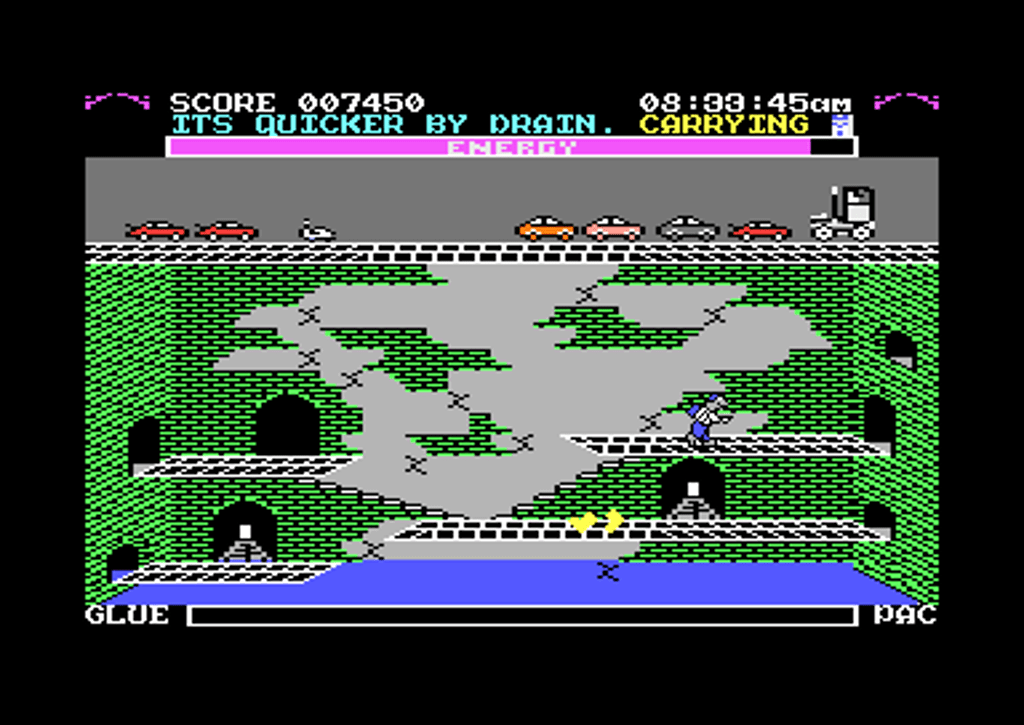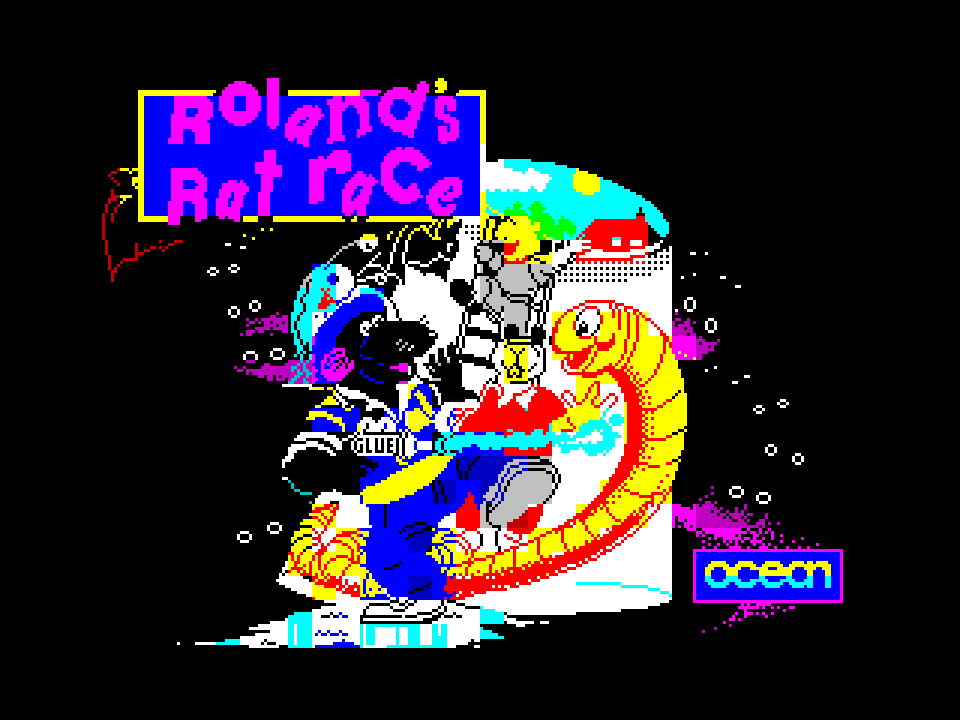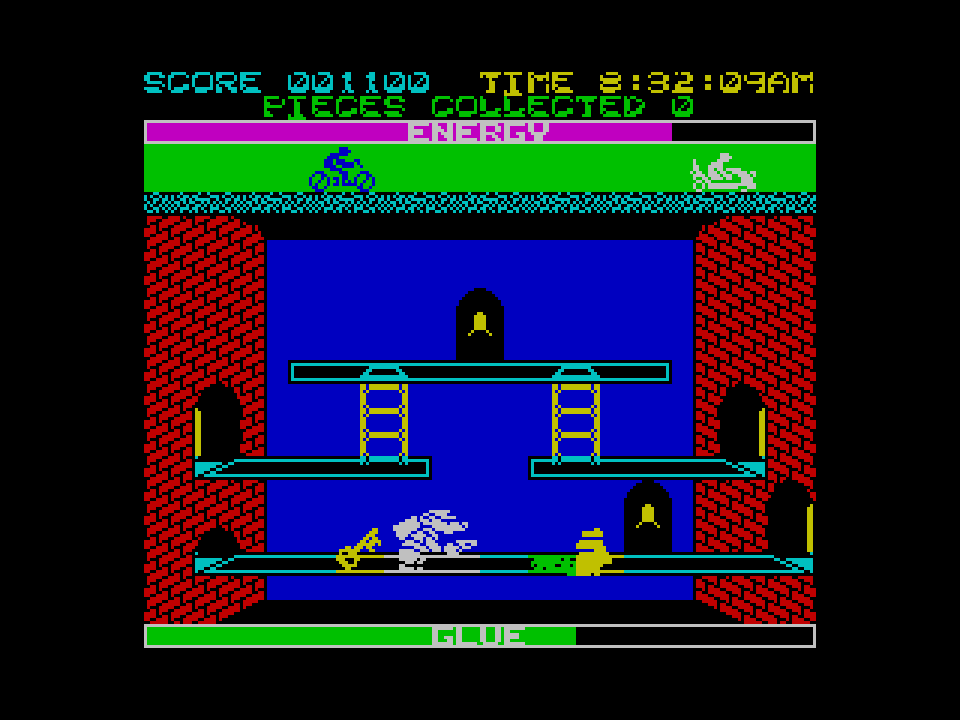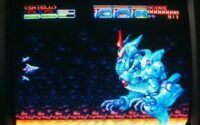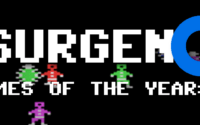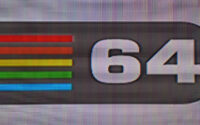Denton Designs – Art For The Machines: Part I
Reading old reviews for Batman-related video games is one sharp, double-edged sword. But in this case, it’s not just about any random Batman-game, but a specific one on a specific platform – Batman Returns on the Commodore Amiga.
Many (most) magazines sure as hell trashed the game for various reasons in a barrage of both valid and seriously unfunny, and sometimes unfair, remarks. But once the laughter got stuck in the throat, it kind of stuck for way too long… Because retroactively, I’m more or less ritually crying blood as everything around the game serves as a painful reminder of the fate of this Amiga-game’s developer: Denton Designs. (Named “Dentons” in the game intro.) The Dentons got the final and ultimately thankless task to create the Amiga-version of Konami’s Coin-Op. It was already over at that point, and it never had the chance to be “arcade perfect” and satisfy the die-hard Batman fans… But the worst part about this gained perspective, i.e., going through all the previous Denton games, is trying to summarize the scope of it all in mere words. In somewhat fair context. But as always, the best way is of course if everybody plays the games.
This retroactive and deep-seated grief over the absence of these Gods among Old School developers has only grown heavier and stronger over the past handful of years while I have been playing, analyzing, studying, and falling deeper and deeper in love with Denton Designs’ games without being able to stop thinking about them. (Not that I’d want to forget about any of them… But maybe I sometimes should pay some attention during meetings instead of trying to figure out how to use Shadowfire Tuner without a manual.) This applies to both the precious ZX Spectrum originals and all the way up to the Amiga days. 1984-1994. That’s about a whole decade in total. So if you decide to read through this series of articles, you should know that ride is fluctuating between unadulterated appreciation, collected information from a web-ton of sources, and historical observations and conclusions. (And not that much healthy fan-boyism…)
…
Amiga Batman Returns is this one title that stands out for other reasons than what the aforementioned magazines brought up with various analogies and more or less worn out expressions. Where people see a barely functional and highly irritating fighting game, some of us see the collective last scream of two dying eras resounding at once – The “commercial end” of the 8-bit computer era, and the beginning of the end for the 16-bit one. Batman Returns’ programmer John Heap had earlier worked on several Denton productions (Like the Spectrum versions of Shadowfire, Enigma Force, The Great Escape, and Where Time Stood Still. Some of the heavier stuff, in other words…!) and, prior to Batman Returns, Audiogenic Software’s Wreckers. (Wreckers was in development for a relatively long time against rising odds. It was supposed to come out on the Spectrum, the Amiga, and the Atari ST in the summer of 1991, but in the end, it was only released for the 16-bit computers.) However, Batman Returns co-programmer Roy Bannon has no Amiga-credits before or after, and very few C64 credits. (World Class Rugby and E.T.’s Rugby League.)
So I can’t help wondering (When you really can’t Google.) if “someone” was a “hired gun” that publisher GameTek brought in “during the last minute” to save the game and make it presentable. It has this “unfinished and unpolished” feel. Or it was more like: The Amiga-people didn’t exactly get the most playable version of the game. (Also imagine how few of them cared to begin with.) Yeah. Googling for answers is another thankless process. And one day, you find yourself wondering why so extremely few publications and outlets talk about Denton Designs today. Because the “history books” are written by the ones who win the computer- and console wars? And finally, you’re left with having to piece together bits of info and do your best to paint some sort of picture.
Okay. Back to that one odd game that indirectly initiated this whole thing. (Except there was at least a year long build up.) Maybe there is something that we all have missed in this merciless and violent maelstrom of disbelief.
The graphics in Batman Returns, which more or less is the sole redeeming factor of the entire project, were done by Ally Noble – At this time, she was one of the very few developers left from the “80s team”. (This iteration of the group must have gotten their original ideas through what can be compared to divine intervention… Or maybe they just had many wonderful ideas.) I mean, during their entire career, Denton Designs were so ahead of their time that there still isn’t one single game that “one-ups” all the things that Shadowfire did, for example – We’re talking about the level of breaking new ground here, including design, execution, add-ons, gameplay, user involvement / motivation, and the always important audiovisuals.
Either way, the art direction and style in Batman Returns at least made the game stand out. But something obviously went very wrong with GameTek, and when the game hit the market, the damage was done. And I believe that it was the final nail in the coffin, if you will. And it’s still frustrating to not know what happened – What it was that hammered in that nail. It’s not like the video game sphere, 1995 A.D., wasn’t in need of more original and well made games, right…?
Still, we’re not here to mourn. No. We are here to put the spotlight on true video game developing excellence that we simply just don’t see that often today either… And one thing that we “never” see either is the advent of entire sub-genres and seamless fusions of these. Perspective: The Dentons invented entire interfaces and integrated systems for their games. Shitty publishers “today” invented “live service” and other shit that one day only will result in one thing: The consumer losing his / her games.
…
Denton Designs’ complete game library consists of thirty titles. And thirty games are what we’re covering in this seven part article – In more or less chronological order. Exact release dates are as usual harder to find than good things in life. (And before anyone asks: “Where the hell is Elite Soccer for the SNES?” – Well, that pretty good game of Footy is credited to Rage Software – The company that bought what was left of Denton Designs around 1994-95.)
Note: Many of the games that this article features are available on the Amstrad CPC, Atari ST, and other platforms as well, but I’m solely focusing on the Commodore 64, the Commodore Amiga, and the ZX Spectrum in this case. The other versions are however mentioned with each respective game.
1984-1985 – RISE TO THE OCCASION
Gift From The Gods (Ocean) – So it was Ocean’s money that financed the very beginnings of Denton Designs, but the gift from the Gods, in the other direction, for the video game sphere, was Denton Designs as a developer. It’s hard to come up with four or even three developers from the early to mid 80s that delivered a more attention-stealing debut than Gift From The Gods. Because what better and more suitable type of game could there have been to kick off a career with than a flip-screen arcade adventure? Because a game with a controllable character over environments in side-view perspective was immediately recognizable – The “style” had already been in the mindset of gamers for years, but let’s not forget that the entire genre fits the machine’s hardware perfectly. And when you more or less have to choose a theme in order to stand out – Why not base the whole thing on Greek mythology? This certainly was the first action-based game on the subject, which also was familiar for everybody who had got accustomed to (and comfortable around) all the Manic Miners and Jet Set Willys. The Dentons obviously didn’t want to follow “set” rules or glance at what “other” developers did and had already done.
And then, the game in question hit the shops. Anyone who plays Gift From The Gods for the first time will notice that there might be just a “few” more screens than in other contemporary releases. Plus the game had a “real” story in the instructions instead of another “You have to collect all keys on all five screens to get out.”. And not only that – Gift From The Gods has multiple supporting characters, and pretty intricate control mechanics. But most importantly is: The big map. (Just over 150 screens!) Challenging games with a few dozen screen and an insane difficulty level is one thing, but a full-fledged arcade adventure more than often benefits from the fact that you have to map it and not tear your hair out as every screen requires fifty attempts to cross. Putting the pen to the paper while playing just feels special, and it’s the exploration aspect that gives the game depth. (Something that you can complete in mere minutes usually lacks something crucial.)
In Gift From The Gods, you play as Orestes hitting the Palace Of Mycenea with the spiritual assistance from two certain bad-asses known in the hood as Zeus and Apollo. Your goal is to remove Clytaemnestra and Aegisthus from the throne and in the process avenge your dad Agamemnon… Zeus eventually gives you a sword (Which is bloody useful when you start running into various blood-thirsty creatures!), and Apollo provides seven Icarus Tears that can be used as “bread crumbs” “Hansel And Gretel”-style to find your way around. And since you involuntarily have ended up in a Labyrinth, it’s all too easy to get lost. Placing tears in certain spots is a good way to figure out where you have been. “Counting” screens with exits is another well-tested method in the absence of landmarks. The tears can be picked up again, and you only lose them if you forget where you put them. (Or if a certain character moves them.)
The misadventures of Orestes in the catacombs “platform game”-naturally includes solving various puzzles and slicing beautifully drawn monsters in order to get out alive. (You get 100 Stamina from the beginning. And if it ever drops to 0, you’re in the RAM of a very specific 8-bit history book.) To get over gaps in the floors and such, you have your winged shoes that work like a very ancient jet-pack – Push up on the Joystick (Or the corresponding “Up”-key.), and you’ll levitate like a King over holes. To walk through doors (You only see the frames in invisible walls.), you face them by “half”-turning left if you’re facing right (and vice versa), followed by moving up “into” the next screen. Flying around the place drains Stamina like trying to make out with a Hydra, and so does stuff like falling from heights, hitting the ceilings, and colliding with huge spiders, etc. (Orestes looks quite sad and down when he gets hurt. Especially heart-broken is he when the game is over and he finds himself surrounded by blue mist in the dark underworld.)
While navigating and avoiding stuff, you also need to locate sixteen rooms containing four Euclidean Shapes (placed on pillars) in each. There are logically 64 of these, but only six of them are of any use. Help from your sister Electra is always valuable since you get the absolute opposite from the Nymphs and the nasty Clytaemnestra – Just like the story books tell, hopefully… Electra does her best to help you finding the Shapes while Clytaemnestra not only shuffles them around, but she also deliberately fucks up your Icarus Tear-markers. She will also kill Electra should their paths cross. Luckily, you always know where Mother has been recently when you see shimmering star-clouds in the air. Slaying monsters has one major advantage that makes it worth the blood, sweat, and tears – Their demise make the fake Shapes vanish, if only temporarily.
Gift From The Gods doesn’t play like your average Willy-clone, which is obvious from the first moment. This is in a whole different league of sophistication with eight-way directional controls including alternating mechanics depending on what you do on screen in specific moments. (Running, fighting, flying, etc.) The game can be played with the keys, but a Joystick is highly recommended. However, the manual doesn’t even attempt to describe the controls. But on the other hand, it’s easy to agree with: “It would be confusing to present a list of joystick / keyboard functions; it’s better for you to discover the rules by experiment.“ This directly translates to: The controls immediately feel natural and good. (And they are the most inviting and most important aspect of the game.)
That the Dentons’ first game stands out among other arcade adventures from 1984 is an understatement. Also take a look at that astonishing loading screen for the game. It’s a work of art with perfectly organized graphics from the game and a comic-book like symmetry that depicts both the symbolism and some of the key events. Simultaneously, it reminds of an ancient mural with two Atlas-figures on both sides of the game title. The title screen is a more basic affair – A short line of scrolling text and “Graphics and code by Denton Designs” displayed beneath Ocean’s logo. (So no Demos or Attract Modes. This single screen was most likely “left” like this to leave more room for graphics and other stuff.)
The advertisement mentions that Gift From The Gods is a “Number 1 Blockbuster” from the “MEGA TEAM” (That’s the Imagine reference. And that’s a certain well known story relating to the game Bandersnatch that simply grew too big for the Speccy.) It’s also a “spectacular arcade adventure” with “stunning animated graphics [that] take you beyond time… into the “FIFTH DIMENSION”. With “INTELLIGENT” controls [that] allow Orestes to perform an astonishing repertoire of feats from the command of the Joystick or keyboard”… Can you believe all the stuff that the marketing people came up with back in the days, huh?! It’s especially shocking because every single word is, of course, true…! This is one very well researched game and both the background graphics, sprites, and animations feature some damn ultra-fine details. And let’s be honest here – Who else was going to bring some Greek drama to the 8-bits? Not Imagine Software, that’s for sure. But since Gift From The Gods rose from the ashes of the legendary “Mega Game” Bandersnatch, there is a strong connection to what Imagine could have become had they survived the implosion.
Gift From The Gods was the first Denton Designs game that was produced by David C. Ward. He went on to produce a majority of the games for Ocean (Way more than 100 titles throughout the years.) and most of Dentons’ games until the developer and publisher went separate ways. (So that equals approximately ten games – With Where Time Stood Still being the last one.) — Release: Winter / Late (December) 1984 · Credits: Simon Butler, Steven Cain, Karen Davies, Graham P. Everett, John Gibson, Roy Gibson, Ally Noble · ZX Spectrum 48K (Cassette)
Note: Graphics artist and designer Steven Cain died, not even 50 years young, on July 19th, 2006 after a two-year long battle with lung cancer.
Shadowfire (Beyond) – From a quite a meritoriously original arcade adventure to one of the most original video games ever conceived – In one leap… Where do we even begin…? Perhaps with something from the instructions. Something as simple as: “Welcome to the world’s first-ever icon-driven adventure”… Shadowfire came along like the apex of an industry and basically turned things upside down. It didn’t merely break new ground – It profoundly shattered the shared part where at least three different video game genres firmly were standing on. The genres in question were: Action-, adventure-, and strategy games. All of them had “already” been outlined with the 8-bit limitations in mind, and all three were quickly evolving in synergy as the programming and designing skills of various developers increased.
But Shadowfire created its own rules, mixed up everything like a master chef coming up with the perfect blend of spices, and served something unique. That’s the parallel. Something icon-driven for those who didn’t wish to type in commands to begin with. And so a game was born that featured an exceptionally creative design – Instead of gimmicks, convoluted schemes, and functions that only the developers could understand. Plus the Dentons didn’t forget to include something as extremely important as an intriguing story. (With dynamic twists!) Otherwise, we would have been left with a game system that hadn’t been used to its full potential. (The system was actually used to make the game last longer through a stand-alone program. But more about this, the Shadowfire Tuner, later on.)
The genre for the plot in Shadowfire is clean-cut, no-nonsense Science Fiction very far away from both Star Wars and Star Trek – With as few tangents as possible. General Zoff plans to conquer worlds of the Empire with the help of his majestic space-craft Zoff V. His megalomaniac plans change dramatically when he hears about another craft called Shadowfire. Because Shadowfire could directly help Zoff take over the entire Empire. One major problem: The plans are in a micro-disc implanted into Ambassador Kryxix’s spine. And Kryxix? He happens to be imprisoned somewhere on Zoff V… And in 100 minutes, Zoff discovers that Kryxix actually has the plans. So what the hell can be done? Well, there is one and only one option: Send in the Enigma Team – Syylk, Sevrina Maris, Manto, Maul, Zark Montor, and Torik. This team is well known as one that gets shit done. Each team member is specialized in something – Syylk is physically strong and therefore a good fighter, Sevrina is the best markswoman around and an excellent locksmith to boot, Manto handles the teleportation duties, the metallic sphere-shaped fellow Maul can take a real beating and also deliver some pain, Zark is the team leader and the translator, and Torik the avian is the group’s scout. But the success of the entire operation naturally depends on your (That’s the player.) ability to command Enigma… (Shadowfire was early in including characters that the player could identify with should he or she wish to do so – Hence multiple protagonists with different personalities.)
Shadowfire starts with you selecting the preferred method of control: Keyboard, digital Joystick, analog Joystick, or Light Pen. Already is this a unique product when it comes to video games. (Games in 1985 just weren’t usually controlled with a Light Pen!) The C64-version also plays one of Fred Gray’s absolute finest and most recognizable tunes. This 87 seconds (!) long mini-symphony says more than any generic one hour movie score. It’s a phenomenally progressive composition with several moods at once. (The ZX Spectrum version of the song is nowhere near as great. For obvious reasons.) Then, you select between an “Old Game” (= Continue current game.) and a “New Game”. You can also save or load a game via this screen. Shadowfire utilizes six windows arranged in two rows. In the top left corner, you see your crew, the crew members’ health / status, the time remaining, and info messages. Health and status are color-coded, e.g., an orange icon means that the character is in defense mode, a purple one indicates attack, and gray signals injuries. The middle top window shows where you are on a top-down eight-way scrolling map. Icons are used to show the position of the enemies as well. The top right window shows the character that you control at the moment. And the bottom row of windows is where you operate everything via a set of menus. (Mission status is always within reach via the Quit-icon.)
First, you have the screen with the Enigma crew lined up. Clicking on a member takes you to his / her character screen which shows his / her strength, agility, and stamina. The pair of scales beneath the power-bars show how much the character can carry. (Maxing it out into the red means that the character is overloaded.) As for the rest, everything is built around the different colored monitor-icons – Green is for “Movement”, yellow is for “Object”, and red is for “Battle”. The Movement-screen brings up eight arrows. The ones that are filled indicates directions that you can move in. The name of the location is also displayed in a separate window. The Object-screen brings up your inventory, the objects in the current location, and the commands – Pick up, Drop, Activate, and Equip. And the Battle-screen has commands for Location Scan, Attack, Defend, and Retreat. Enemies close-by are shown as well, and you also choose which of the eight possible directions to attack in…
The first part of the mission has Manto transporting his crew aboard Zoff V with a portable teleportation device. This is the 100% perfect way to learn how the interface works. Get past this, and you pretty much know how to play Shadowfire. The tricky part is to figure out what the various icons do. So to begin with, you select the Pick-up command, click on the transporter, click on the Activate icon, and choose one of three destinations inside Zoff V. (This is how you design an interface. No convoluted schemes or combos. Logic.) But as you start looking for Kryxix, you will naturally encounter trouble. General Zoff has a bunch of henchmen that will try to murder your asses. Apart from Captain Churl, the Marshalls (Cavn and Xator.), plus the Squad Leaders (Targ are the human ones and Lavv are the robots.), there are also Troopers. (The humanoid ones are known as Glov, and the robotic are called Eugs.) All this equals fifteen Squad Leaders and 24 Troopers… (All characters even have individual names.) So you’d better gear up with some weapons! (Before you zap over to Zoff V, that is.) There is a total of eighteen weapons in the game – Everything from combat knives and garottes to Amuta Rifles and blast grenades. Finally, there are eleven “mission objects” in Shadowfire… And you might just need them all…
The game is a masterpiece regardless of which platform you play it on. As for the differences between the C64- and Spectrum versions, there are a couple worth mentioning. Both versions are the exact same game, but if you get hopelessly intrigued by the story, fall in love with the interface, adore the SID-soundtrack, and get hooked by the tactical combat and the whole exploration aspect, you might want to play both variants. The Spectrum-version doesn’t have the audio control on the Team screen. There are two arrows (Up and down.) that change the volume of Fred Gray’s second (34 second) tune. Turn it all the way up, and you only hear the music. Turn it down, and the game emits this uninterrupted hypnotic pulse behind the sound effects. (Like alerts and notifications.) On low volume, the music has this very pulse as an additional rhythm in the foreground. It’s a phenomenal effect.
As for the gameplay, the Speccy variant runs a bit smoother and responds slightly quicker that its counterpart. (I have no idea how the Amstrad CPC version plays.) The icons and portraits on the C64 look colorful and more cartoon-esque while the monochromatic Spectrum variants have more detail and a more serious and cold tone. (They look bloody good as well.) The weapons and mission objects differ slightly, though. For example, the Sonic Disrupter is called a Sonic Cannon on the Spectrum, and the Photon Rifle had to become a Shedir Rifle. (And it seems that the gas mask is missing in the C64-version?)
There just has to be a nice loading screen too with the cool game logo. The art on the C64 paraphrases Zoff V from the original box cover. The loading screen artwork in the Spectrum-version looks entirely different with a smaller, red space-craft with all guns blazing. (The Enigma Team’s ship perchance?)
Shadowfire is a solid piece of video game history and something that begs the question: Are there absolute video games? Meaning: Games that don’t leave room for any improvements whatsoever, considering all limitations that surround it? Either way, Dentons’ game survived itself with an afterglow that basically hasn’t been seen or even spotted since it was released. It’s quite melancholic to know that there would be no plausible way to continue the Shadowfire-saga for a longer period. If there is one thing I believe we “all” can be happy about, it’s the fact that the story wasn’t milked to death by, Satan forbid, outsourcing the intellectual property to developers that didn’t “get it”. Sure, the game was followed by the also ingeniously well-designed Enigma Force about one year later, but perhaps that’s the beauty of it at the same time – That the phenomenon lives on through the memories of the fans instead.
Shadowfire is still so far ahead of its time that it could be released again with a couple of new missions and maybe some additional Bonus-stuff, and it would still wipe the floor with many modern similar games design-wise. Because how the hell do you out-Shadowfire Shadowfire unless you invent an entirely new interface and fuse whole genres? I’m not even sure that it can be done anymore. And that furthermore strengthens the game’s monumental status. Plus – There is a Shadowfire Tuner…!
But that one obstacle that prevents “everybody” from falling in love with Shadowfire at first sight is, when it comes down to it, that thin wall between the player and the interface. Still, the program itself is so attractively presented that it should encourage anyone who decides to load it up to figure it out. And the instructions are just a Google-search away in this day and age…
We also have to say a few words about that box cover art… Or two words are enough: It’s perfect. It has got every aspect of the fight between good and evil in the story – With an equal emphasis on both. General Zoff menacingly staring at us in the background beneath his flying fortress. And the Enigma Team in the foreground – Sevrina, the obvious heroine, in the middle with Torik, Zark, Manto, Syylk, and Maul by her side. For some no doubt utterly idiotic reason, the original box art was changed, for the worse of course, in the version that Mindscape published. Everything about it is and looks wrong – Everything from the logo to the fact that Maul has been reduced to the size of Syylk’s face.
The instruction manual thanks Simon Butler, Chas Davies (Karen Davies’ brother who was a graphics designer for the Spectrum.), and Ian Weatherburn. (R.I.P.) Weatherburn reportedly invented the game’s icon-based system when he was at Imagine and the team was slaving away on Bandersnatch. And out of something no doubt frustrating came something extraordinary in the end. — Release: Spring (April) 1985 · Credits: (C64) Simon Butler, Steven Cain, Dave Colclough, Karen Davies, Fred Gray / (ZX) Simon Butler, Steven Cain, Fred Gray, John Heap, Ally Noble, Colin Parrott · Commodore 64 (Cassette / Disk) / ZX Spectrum 48K (Cassette)
Note: Both the C64- and the Spectrum-versions were distributed on the same cassette.
Shadowfire was additionally released on Amstrad CPC over a year later, in May 1986.
Spy Hunter (U.S. Gold) – But hold on a minute… Isn’t The Spy Hunter that Bally Midway’s classic Coin-Op from 1983? Absolutely. And at the beginning of their career, Denton Designs were hired to develop the ZX Spectrum-port. After a literal game-changing title like Shadowfire, it might sound strange to even mention Spy Hunter in the same sentence, but then again – The game was published by U.S. Gold who sure as hell had their own ideas for marketing and distributing games across the hemispheres. Interpret that however you like. Let’s just say that everything wasn’t quite “gold” that got released through them. However, Spy Hunter on the Speccy is a more than solid affair and falls under the category of arcade conversions that are “as good as they could get”.
There is one consistent feature in Denton’s games on the Spectrum, and it’s the Keyboard / “Re-define keys”-option. This isn’t exactly an uncommon feature, but it’s always nice to just be able to punch in the ones you prefer for controlling a game – Usually: Up, Down, Left, Right, and Fire. Sure, the controls where one entire row of keys is allocated for one direction is pretty neat once you get over the period of adjustment, but many of us simply prefer WASD when there be no Joystick.
Spy Hunter is, as at least half the planet knows, a vertically scrolling action / driving game where you speed along a winding highway in your Spy Car and do two other main things: 1) Ram other cars off the road. (Preferably into trees.) 2) Shoot other cars. It’s a kill or be killed scenario, so there is no plot or anything. (Not that it’s needed either – Just like there isn’t need for a plot or background for any long car chase, the “James Bond”-influences notwithstanding.) The ride across the ~530 screens high map consists of dead ends, icy roads, bridges, and parts where you in a split second exchange the car for a speed boat to get across a body of water. (And back to a car when you have to get back on the road.) All the time, you are hassled by various agents on the enemy’s side. There are the Road Lords (With bulletproof cars, so they have to helped to the state of FOADIAF by ramming them to fiery deaths.), the Switch Blades (With circular saw blades on their wheels, so you’d better annihilate them before they get a change to crash into you and slice you up.), the Enforcers (They shoot back at you. So you’d better them shoot first too.), the Copters a.k.a. Mad Bombers (Choppers that try to drop bombs on you.), Barrel Dumpers (These ruin your shit on water with the help of barrels.), and one Doctor Torpedo. (Who tries the same thing, except with torpedoes.)
After selecting between a Novice and an Expert game, you roll out of the “Weapons Van” and put the pedal to the metal. Speeding ahead, you never know which branch is a dead end that coincidentally ends with you dead. This means that you need to memorize at least parts of the road map. Wreck your car due to collisions or enemy fire, and you lose time. When you see the Weapons Van ahead, you can roll into to upgrade your gear to rockets (For taking out the Mad Bombers.), oil slicks, and smoke screens. You gain points as long as you’re on the move, and send enemies to their instantaneous deaths. The Road Lords and Switch Blades get you 150 points each while the Copter is worth 700. But also know that non-stop destruction that affects innocent drivers reduces your hard-earned points.
Sadly, Spy Hunter on the Spectrum isn’t too close to being as fluid or smooth as the C64-version. But here’s the important thing: Nothing major in the shape of features or mechanics seem to be missing. The screen-scrolling is pretty jittery as it jumps a couple of pixels at a time. But to be fair, it is less noticeably when you drive faster and concentrate on not crashing or dying in burning wrecks. And one thing that you can’t do in this version while shooting is… Moving the vehicle. This does feel quite strange when compared to other versions of the game. (Like you can move and shoot in the C64-version.) But it’s not impossible to get used to it… And it does make the game more challenging. Spy Hunter has well-defined graphics that represent the arcade game as closely as possible, but the game as such doesn’t reflect Denton Designs as a game developer at all. But “someone” had to make a Spectrum version of Spy Hunter (So why not a developer that cares, right?), and it was of a high quality enough to sell well. Plus the game is kind of a classic, regardless of which platform it appeared on.
That exceptionally good looking loading screen by Karen Davies (The graphics artist for this version.) even has that amusing U.S. Gold-logo that’s supposed to be a seal for “All American Software”. Absolutely. For a game entirely produced in the U.K. And SEGA, who made the game available for the home computers, isn’t particularly American either. — Release: Spring (May) 1985 · Credits: (ZX) “Denton Designs”, Frederick David Thorpe · ZX Spectrum 48K (Cassette)
Note: The Commodore 64-version of Spy Hunter was entirely put together by R.B. Stuart and hence has nothing and zero to do with Denton Designs.
Roland’s Rat Race (Ocean) – While the computer- and video game press and enthusiasts, including other daylight-fearing, Coke-guzzling, CRT T.V.-radiated boys and girls of all ages waited and built up expectations for the next Masterpiece from Denton Designs (And what else but super-high expectations could a game like Shadowfire lead to?), Ocean published this “middle game” based on the puppet character known as Roland the Rat. Roland became famous on British early morning television in the mid-80s, and he did “everything” from rapping on Top Of The Pops to appearing alongside Samantha Fox, Frankie Goes To Hollywood, and other celebrities in the BBC-produced series. At this point, Ocean was already specialized hard core in releasing “platforms and ladders”-games on both their main platforms – There was the original Hunchback, Barmy Builders, Cavelon, Pud Pud, Eskimo Eddie, Gilligan’s Gold, Mr. Wimpy – The Hamburger Game, Bangers And Mash, and its sequel Spellbound. All of these came out in 1983-84, and Hunchback II – Quasimodo’s Revenge was a real hit. It was like the stars aligned, or something…
But one has to remember that when the artists and coders of Denton Designs were hired to produce a “middle game” that wasn’t from their own I.P., it was still a couple of notches above most other Ocean-published games in the same genre. (If we solely look at the features and mechanics.) This would become even more obvious in 1985. I’m not saying that more efforts were put into “Game A” than “Game B” since it really can’t be measured objectively, but I am saying that sometimes, “Game A” had more game than “Game B”… The only other “similar” (not very) game that Ocean released this year was Kong Strikes Back! on the C64. (Which already was out on The Spectrum. And let’s also not forget for one moment that another exclusive game from the Dentons was in the works!) And what was Ocean’s most exciting release up to this point? I’m sure everybody has a candidate.
The loading screen for Roland’s Rat Race looks totally different in the Spectrum-version than it does on the C64. The pixel artist for the latter didn’t put his signature on that phenomenal Stendhal Syndrome-inducing piece, but kind of has the “early Ocean / Imagine”-loading screen vibe going on. (Like the ones for Green Beret, Comic Bakery, Yie-Ar Kung Fu, etc.) On the Spectrum, the screen at least looks like the cover box art for the game. With its own eye-catching colorissions. (That’s a bastardized portmanteau word for “colors” and “collisions”.)
The “rat race” unsurprisingly stars Roland Rat who has to get to the T.V. studio before his show begins at 9 AM, and that’s about half an hour away. (Real-time.) Alas, there are two immediate problems: Roland wakes up far too late due to a malfunctioning alarm clock. And if that wasn’t bad enough, his car has stalled and refuses to start… Well, there is a third problem as well – Roland’s friends Kevin and Errol have ended up being kidnapped by the Nasties. And let’s add a fourth problem for good measure – Roland has no other option but to get to work via the sewers since the underground provides both shortcuts and means of transportation…
And the sewers are the majority of the game itself – 35 flip-screens of tunnels including a railroad at the bottom of the map. (The upper part of the screens on the upper part of the map shows animated morning traffic above the playing area.) The objective is to find nine parts of a door and a key to that. (This door and key is the answer to all Roland’s problems this morning.) The pieces have to be carried, one by one, to a specific spot. All the time, Roland is stalked by pairs of walking yellow Wellingtons that drain his energy on contact. Roland fortunately remembered to pack his Instant Stic-o-Matic glue gun that shoots the finest blobs of glue. The glue stops the Wellies momentarily in their tracks. (The glue affects Roland’s movement as well.) But the best strategy is to stay as far away from the Wellies as possible… Which isn’t possible in a “platforms and ladders (And stairs.)”-style game where there are multiple narrow paths. (And some dead ends.) The glue can also be used to stop the train (!) that runs back and forth along the railroad. The train turned immobile by the glue can be entered so that Roland can ride it across the map. Miss to halt the train and it hits like that alarm clock going off on Monday morning. And at the end of the game, Roland naturally has to rescue his two friends and get out.
The game-screen displays the time left in the top right corner of the screen. There is an energy-bar for Roland and one for the amount of glue in his gun. Both can be re-filled – The former with the help of burgers, apples, and other stuff that is lying around in the sewers. Delicious. As for the Instant Stic-o-Matic re-fill… Find more packs of glue!
Although the game isn’t particularly long-lasting or doesn’t hold the interest for a longer time, it’s still quite a charming and a fun cult-game to load up every now and then. The biggest difference between the C64- and Spectrum-versions are of course the graphics and the sound. The games are equally big on both platforms, although the sewers’ design differ significantly. The details on the Speccy-Sprites are clearly noticeable too. But the part where the C64-version shines is in the sonic one – Martin Galway’s phenomenally catchy tunes accompany all parts of the game. (Title screen, in-game, and Hi-score table.) But as far as playability goes, both versions get the job done, although the tempo varies slightly. (The Spectrum-version is basically as fluid as the C64 one. And there are no issues with the controls in either – Even if they feel slightly different.)
The C64-version was programmed by David Collier who coded some of Imagine’s and Ocean’s better 80s games like Terra Cresta, Target Renegade, Yie-Ar Kung Fu, Arkanoid, and Green Beret. — Release: Spring (May) 1985 · Credits: (C64) David A. Collier, Martin Galway / (ZX) “Denton Designs”, Frederick David Thorpe · Commodore 64 (Cassette) / ZX Spectrum 48K (Cassette)
(To be continued.)

